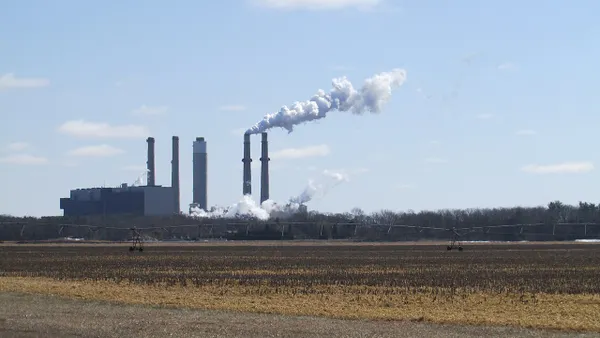Dive Brief:
- Competitive Power Ventures says its recently-completed CPV Fairview natural gas-fired, combined-cycle plant in Pennsylvania is the first generation station of its size to be able to switch to burn high contents of ethane blended into natural gas, an innovation intended to cut fuel costs, CPV announced Tuesday.
- The ethane-blending capability comes from a combustion system developed by General Electric, part of its efforts to introduce turbine technology that can allow natural gas-fired power to compete with an increasing amount of renewable energy on the grid.
- Recent tests at the 1,050 MW Fairview station show that running on the ethane blend does not increase emissions or affect the plant's output or efficiency, CPV VP of Construction and Engineering Jeff Ahrens told Utility Dive in an interview.
Dive Insight:
Ethane is a compound derived from natural gas and often used as a feedstock for industrial plants that produce ethylene. Like natural gas, the price of ethane fluctuates in commodity markets and can trade at a premium or discount to natural gas.
For example, like propane and other hydrocarbon products, processing plants remove ethane from natural gas, but sometimes ethane prices are not high enough to justify the cost to processors of removing it from a natural gas stream, according to the U.S. Energy Information Administration.
CPV intends to capitalize on the times when ethane is at a discount to natural gas. The $1 billion Fairview plant, completed in late 2019, is located near a Sunoco pipeline that carries a number of different natural gas-derived products, including ethane. A GE vaporizer "the size of a delivery truck" can turn liquid ethane from the pipeline into a gas that can be blended into natural gas to make a fuel mixture up to 25% ethane, Ahrens said.
It takes 30 minutes for the plant to convert from burning just natural gas to burning the blend, and CPV plans to make that switch at times when ethane is cheaper than gas.
A natural gas-fired plant that blended ethane could save about 3.2 cents per kWh in lower fuel costs, according to a 2015 paper from GE. A GE spokesman told Utility Dive the company could not share a more recent estimate for the potential savings.
This ethane capability, provided by GE’s DLN 2.6+ combustion system, makes Fairview "the first plant of its kind," CPV CEO Gary Lambert said in a statement. According to GE, the DLN 2.6+ system is intended to improve operational flexibility and lead to faster dispatch times for gas turbine plants, an important attribute as "demand for renewable resources" drives an "increased needs for cyclic operation."
Natural gas power’s CO2 emissions profile has led to extra scrutiny from regulators around the country as states attempt to meet CO2 reduction goals. But compared to coal-fired power, natural gas plants produce fewer greenhouse gases and can more efficiently cycle up or down to match intermittent resources like solar and wind. Meanwhile, GE is betting on natural gas continuing to serve as a major source of power generation as it relies on gas turbine sales to help drive its power business back to profitability.
The vaporizer and connection to ethane supply at Fairview only increased the capital costs of the plant by about $1 million, according to Ahrens. A recent performance test at Fairview found “no impact” on performance and electricity output when running on the blended fuel, and also no increase in the amount of emissions, including CO2 and those regulated by the plant’s air permit like NOx, SO2 and particulate matter, he said.
In 2015, West Virginia regulators approved a 549-MW combined-cycle natural gas-fired plant that also planned to use GE turbine technology to burn ethane, reported as the first at the time. The proposed Moundsville facility was delayed and transferred to a different developer, Quantum Utility Generation. The plant was intended to be operational in 2018, but in November of that year was reported to have not begun construction. Quantum Utility Generation did not immediately reply to a request for comment from Utility Dive.













